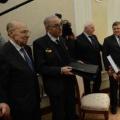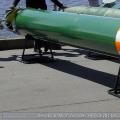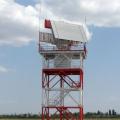- MS Power Point presentation (application)
- Computer, projector
Reagents
- A mixture of iron and sulfur powders, a solution of sodium chloride, a mixture of sand and water, a solution of methyl orange; filters, evaporating dish, laboratory rack with ring, spirit lamp, funnel, glass rod, beakers, flasks, magnet, pipette.
Demo experiment:
- Separation of the mixture by filtration;
- Separation of the mixture with a magnet;
- Separation of a mixture of substances by evaporation.
Task cards for group work.
Separation of a mixture (solution) of a soluble substance and a solvent:
Salt solution, laboratory tripod with ring, porcelain dish (evaporating), spirit lamp, crucible tongs, glass rod.
Separation of a mixture of a water-insoluble substance and a solvent (soluble substance):
Laboratory tripod with a ring, funnel, filter paper, glass rod, chemical flask or beaker.
Separation of a mixture of iron and sulfur:
Iron filings, sulfur powder, magnet, 2 filters.
Filter, methyl orange solution, pipette.
During the classes
I.Organizing time. Homework check.
- What compounds are called oxides? (Oxides are complex compounds consisting of two elements, one of which is oxygen with the oxidation state (-2))
- What compounds are called acids? (Acids are complex substances consisting of hydrogen atoms and an acidic residue)
- What compounds are called bases? (A base is a complex substance consisting of metal atoms and one or more hydroxo groups OH-)
- What compounds are called salts? (Salts are complex substances consisting of metal atoms and acidic residues)
2. Verification work (5-7 minutes) on sheets. On the slides 1-2- questions of verification work.
3. Testing work is handed over to the teacher (the results are announced in the next lesson).
II.Preparation for the perception of new material. Topic announcement.
1. Conversation
1. We know very well what cleanliness is. A clean notebook, clean hands, a clean sheet ... And what substance is considered clean? Are there pure substances in nature? What is the difference between a pure substance and a mixture of substances?
2. What do you think will be the topic of our lesson today? (slide 3)
2. Writing the date and topic of the lesson by the students in a notebook.
What do you think we should find out in the lesson today?
Goals lessons are discussed with students.
Students ask: find out what substance is considered pure and what is a mixture; find out where pure substances and mixtures are used; learn how to separate substances.
As a result of the discussion - slide 4.
3. Explanation of the new material.
On the this stage the lesson the teacher forms the concept of a pure substance and mixture. Students know the concept of "substance" (this is what physical bodies are made of). Therefore, first we give the definition "Mixtures of substances".
The teacher invites the students to look at the mixtures on the demonstration table and examples of mixtures presented on slide 5.
Then the guys give a definition mixes, how systems from their several substances in direct contact with each other... This wording appears on the slide after a mouse click.
The teacher adds that there are no absolutely pure substances in nature. Substances are found mainly in the form of mixtures. The teacher gives examples of mixtures, the guys write them down in a notebook: air, sea water, milk, metal alloys, solutions, fog, etc. He talks about air as a mixture, which consists of gases - nitrogen, oxygen, argon, etc. ( slide 6).
Look closely at the mixtures on the table. What is the difference between them?
Homogeneous
Heterogeneous
Sugar solution in water, salt solutions, air
Fe + S mixture, sand and sugar, clay with water, sand with water
Heterogeneous mixtures are called in which particles of the substances that make up the mixture are visible with the naked eye or with the help of a microscope.
Homogeneous are called mixtures in which it is impossible to notice particles of substances included in the mixture (even with the help of a microscope).
For scientific research and industry, mainly require pure substances. Some impurities, even in small amounts, can dramatically change the properties of substances. For example, in semiconductor technology, ultrapure substances are used, where impurities are only 1 atom per million atoms of the basic element (Si, Ge). Exceeding the norm leads to a sharp deterioration in the semiconducting properties of these substances. At the same time, it is necessary to emphasize that it is impossible to obtain an absolutely pure substance, since any pure substance contains, although an insignificant small amount of impurities.
Do you think seawater and pure distilled water will have the same properties? (guys assume not). Slide 8... The teacher explains the conditions of the experiment: distilled and sea water was heated to boiling in 2 vessels. After a certain time, the boiling points in these vessels were measured using Archimedes sensors. We discuss the results of the experiment together. The problem arises: “Why sea water t bale is not constant in different periods of time in comparison with t bale of distilled water? "
The students suggest that the salinity of the seawater affects the boiling point.
With the help of the teacher, the definition is formulated “A pure substance is a substance that has constant physical properties (boiling points, melting points, density).
In notebooks, the guys write down the definition of "pure substance"
Clean is called a substance that has constant physical properties.
The teacher adds that in a pure substance there are impurities, although there are small amounts, they do not affect the physical and Chemical properties... An example of a pure substance is distilled water.
Demonstrated slide 9.
The guys write down their conclusions in notebooks.
The teacher draws the attention of children to the distinctive feature of mixtures “In mixtures, each of their constituent substances retains their individual properties. To confirm this, the teacher conducts experiments:
- Demonstration of the separation of a mixture of iron and sulfur using a magnet (work out with the child in advance the method of performing the experiment and then the student will conduct the demonstration)
The next step of the lesson- acquaintance with the main methods of separation of mixtures, which are presented in the form of a diagram: Slide 10.
At the same time, it is specified on what physical properties of substances each separation method is based. On the slides 11-13 shows the areas of application of different methods of cleaning inhomogeneous mixtures.
Demonstration of separation of a mixture of sand and water by filtration. Attention is drawn to the correctness of the experiment ( Slide 11).
Acquaintance with the methods of separation of homogeneous mixtures continues with the help of slide 14, the attention of students is focused on the physical properties of substances used in this separation method.
On the slides 14-18 shows the areas of application of different methods of cleaning homogeneous mixtures.
4. Anchoring
1. Group work.
Each group was given the task "How to split the mixture?"
I had to describe my actions. After 1 minute, each group voiced their answer. In the tasks, life situations were used, where it was required to purify water in field conditions, etc.
2. Answer the questions on slides 19 - 21
5. Reflection.
What new have you learned in today's lesson?
What do you remember?
What did you like and what did not work, in your opinion?
6. Summarizing
7. Homework:§ 23 ex. 1,2,4
Creative task.
1. Make tasks for the separation of the mixture.
2. You have been given a mixture of salt and chalk.
Suggest ways to separate this mixture.
View document content
"Presentation for the lesson" Pure substances and mixtures ""
WRITE OUT SEPARATELY FORMULAS FOR OXIDES, ACIDS, BASES AND SALTS:
KCl, MnO 2, H 2 SO 4, KOH,
- KCl, MnO 2, H 2 SO 4, KOH,
CO 2, NaNO 3, H 2 CO 3, Al (OH) 3.
Name the connections

Make formulas of chemical compounds:
Sodium oxide
Hydrochloric acid
- Sodium oxide Hydrochloric acid
Calcium phosphate
Barium hydroxide

Pure substances and mixtures. Methods for separating mixtures

Lesson topic: Pure substances and mixtures
Lesson objectives:
- Find out which substance is considered pure.
- What is a mixture? What mixtures are there?
- Figure out the differences between a mixture and a chemical compound.
- In what ways can mixtures be separated?
- Where are pure substances and mixtures used?

A mixture is a system of several substances.
- Air
- Milk
- Metal alloys
- Solutions
- Fog
- Concrete


Homogeneous
Heterogeneous
suspensions
liquid
emulsions
Gaseous
solid


- A pure substance has a constant composition.
- A pure substance has constant physical properties (density, hardness, electrical conductivity, t bale, t melt)

Methods for separating mixtures
Inhomogeneous mixtures
Upholding




Methods for separating mixtures
Homogeneous mixes
Evaporation
Distillation (or distillation)





- Tap water
- Carbon dioxide
- Sea water
- Milk
- Oxygen

2. The mixture is:
A. Distilled water
D. Aluminum

- Air
- Water in the river
- Water in a cloud
- Sugar
- Petrol
- Salt

Homework:
§ 23, ex. 1,2,4
Creative task.
1. Set up tasks for the separation of a mixture of different substances.
2. You have been given a mixture of iron filings, salt and chalk. Make a plan for separating this mixture.
To use the preview of presentations, create yourself a Google account (account) and log into it: https://accounts.google.com
Slide captions:
Pure substances and mixtures. Physical phenomena in chemistry.
Substances that have constant physical properties are called pure.
A mixture is a combination of different substances that can be separated because they have different physical properties (eg different boiling points). The substances in the mixture are not linked by chemical bonds, so they can be separated from each other.
Mixtures Homogeneous (homogeneous) Heterogeneous (heterogeneous) Solutions of table salt (sodium chloride) and sugar in water, air Mixture of table salt with sand, clay with water, iron filings with clay
Problem: How to get pure substances?
The basis for obtaining pure substances were physical processes that occur without changing the composition of a substance, but with a change in the aggregate states of substances.
Inhomogeneous mixtures Sedimentation Filtration Magnetic effect Sedimentation of clay particles in water. It is used for the purification of drinking water It is used for the purification of drinking water Separation of iron from other substances
Homogeneous mixtures Evaporation Crystallization Distillation (distillation) Chromatography Separation of sodium chloride from sea water Sugar production Obtaining distilled water Separation and purification of medicinal substances
How to purify water on a hike?
Given mixtures: - iron and copper filings; - sawdust and clay; - river sand and sugar. Suggest ways to separate them.
On the subject: methodological developments, presentations and notes
Lesson summary "Pure substances and mixtures. Methods for separating mixtures"
Lesson objectives: 1. Educational: Give the concept of a pure substance and a mixture of substances, the similarities and differences between them. To reveal the meaning of mixtures in nature and human life. 2. Developing: F ...




